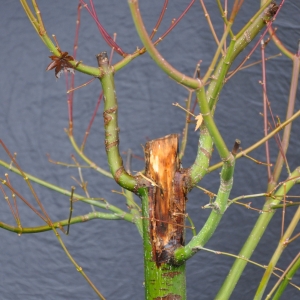To be clear, winter die back isn't necessarily caused by a pathogen. Acer palmatum, for one, has very low phloem pressure when not in leaf - at least that is how I interpret the phenomenon.
Carbohydrates and auxin flow down the tree in the phloem (aka, inner bark). A pressure is developed at the leaves by living cells that actively load these materials with water into the phloem tubes, This little bit of pressure means that this stuff may actually be transported up, against the force of gravity. So, if you pruned in an internode during the growing season, the cambium and bark can stay alive. Importantly, auxin can be moved up and get loaded into the Polar Auxin Transport stream in cambium cells that importantly signals 'life above'. During winter this pressure drops and die back inevitably proceeds to the node below where buds maintain the PAT. When this happens, the cambium dies, causes the bark to darken and signals living cells in the wood (the the effect) that there is no life above, seal off the xylem here.
All very hand wavy, maybe, but it does explain why die back is seen to be a consequence of winter. However, one can observe
this same problem when layering some varieties of acer palmatum - Higasayama, for one (which I attribute to having very low phloem pressures even during the growing season).
If one chops late in the season, there is little or no time to grow new phloem tissues and one gets this kind of die back - the pattern of phloem flow is quite clear.

On the other hand, it is less likely to happen when chops or major cuts are made in spring, giving time to grow new phloem that distributes stuff more evenly around the bole. I made this chop in March 2015

and instead there is no significant die back in evidence a year later

Moreover, as
@Paulpash noted, sap producers (branches) distributed around the bole help to limit the die back (over just buds on a node.
In case I've gone too far afield, my point is: with acer palmatum,
die back to a node (and maybe further) is inevitable in winter. NO PATHOGEN IS INVOLVED - simply, be aware.


